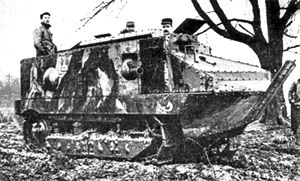Schneider CA1
| Schneider CA | |
|---|---|
 |
|
| Type | Tank |
| Place of origin | France |
| Service history | |
| In service | 1916-1918 (France) 1921-1936 (Spain) |
| Used by |
France Kingdom of Italy Spain |
| Wars |
World War I Rif War Spanish Civil War |
| Production history | |
| Designer | Schneider |
| Manufacturer | SOMUA |
| No. built | 400 |
| Specifications | |
| Weight | 13.6 tonnes |
| Length | 6.32 m (20 ft 9 in) |
| Width | 2.05 m (6 ft 9 in) |
| Height | 2.30 m (7 ft 7 in) |
| Crew | 6 |
|
|
|
| Armor | 11 mm + 5.5 mm spaced |
|
Main
armament |
75mm Blockhaus Schneider |
|
Secondary
armament |
2×8 mm Hotchkiss M1914 machine guns |
| Engine | Schneider 4-cylinder petrol 60 hp (45 kW) |
| Power/weight | 4 hp/tonne |
| Suspension | Coil spring |
|
Operational
range |
30/80 km |
| Speed | 8.1 km/h (5.0 mph) |
The Schneider CA 1 (originally named the Schneider CA) was an armoured fighting vehicle developed in France during the First World War. Although not a tank in the modern sense of the word, not being a turreted vehicle, it is generally accepted and described as the first French tank.
The Schneider was inspired by the need to overcome the stalemate of trench warfare which on the Western Front prevailed during most of the Great War. It was designed specifically to open passages for the infantry through barbed wire and then to suppress German machine gun nests. After a first concept by Jacques Quellennec devised in November 1914, the type was developed from May 1915 onwards by engineer Eugène Brillié, paralleling British development of tanks the same year. Colonel Jean Baptiste Eugène Estienne in December 1915 began to urge for the formation of French armour units, leading to an order in February 1916 of four hundred Schneider CA tanks, which were manufactured by SOMUA, a subsidiary of Schneider located in a suburb of Paris, between September 1916 and August 1918.
The tank was of the "box" type, lacking a turret, with the main armament, a short 75 mm cannon, in the right side. Generally it is considered a very imperfect design, even for its day, because of a poor layout, insufficient fire-power, a cramped interior and inferior mobility due to an overhanging nose section which had been specially designed to crush through barbed wire belts. Improved designs were almost immediately initiated but the production of these, the Schneider CA 2, CA 3 and CA 4, was eventually cancelled.
The Schneider CA 1 tanks were widely used in combat during the last war years. Their first action on 16 April 1917 was largely a failure, the tank units suffering heavy losses, but subsequent engagements were more successful. In 1918 the Schneider tanks played an important role in halting the German Spring Offensive and breaking the German front in the French summer offensives. They were active until the end of September 1918, less than two months before the Armistice of 11 November 1918, their numbers having dropped considerably due to attrition. After the war the surviving tanks were mostly rebuilt as utility vehicles but six Schneider tanks were deployed by Spain in the Rif War in Morocco, and the type saw its last action in the beginning of the Spanish Civil War.
...
Wikipedia
